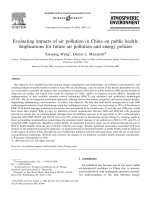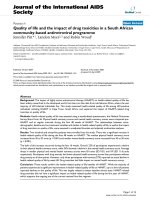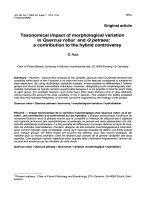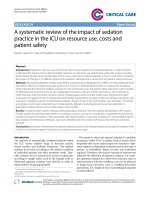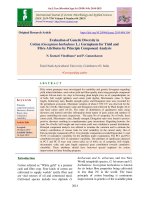Impact of IBA and NAA on rooting and its growth parameters of air layers in guava (Psidium guajava L.)
Bạn đang xem bản rút gọn của tài liệu. Xem và tải ngay bản đầy đủ của tài liệu tại đây (228.27 KB, 7 trang )
Int.J.Curr.Microbiol.App.Sci (2019) 8(10): 2041-2047
International Journal of Current Microbiology and Applied Sciences
ISSN: 2319-7706 Volume 8 Number 10 (2019)
Journal homepage:
Original Research Article
/>
Impact of IBA and NAA on Rooting and its Growth Parameters of Air
Layers in Guava (Psidium guajava L.)
Bhuriya Verma1, Poonam Bhadauriya1, Usha Parmar1,
Raj Kumar Dhakad2* and K. S. Tomar1
1
Deparment of Horticulture, fruit science, college of Agriculture Gwalior, Rajmata Vijayaraje
Scindia Krishi Vishwa Vidyalaya, Gwalior, Madhya Pradesh, India
2
Deparment of vegetable science, School of Agriculture and Rural Development,
BRAUSS Mhow, M.P, India
*Corresponding author
ABSTRACT
Keywords
Callus, NAA, IBA,
Primary and
secondary roots
Article Info
Accepted:
15 September 2019
Available Online:
10 October 2019
The present investigation entitled Impact of IBA and NAA on rooting and its
growth parameters of air layers in guava. (Psidium guajava L.). The experiment
was conducted at the Nursery area, Department of Horticulture, College of
Agriculture, Rajmata Vijyaraje Scindia Krishi Vishwa Vidyalaya, Gwalior (M.P.)
during the session 2016 - 2017. The experiment was laid out in Randomized Block
Design with 16 treatment combinations consisting of three level of IBA, Io = 0
ppm (Control), I1 = 5,000 ppm IBA, I2 = 10,000 ppm IBA, I3= 15,000 ppm IBA
and three level of NAA, N0= o ppm (Control), N1= 5,000 ppm NAA, N2 = 10,000
ppm NAA, N3 = 15,000 ppm NAA. Maximum rooting and its growth parameters
were found significantly superior under the treatment of I3 (15,000 ppm IBA)
followed by treatment I2 and I1 and for NAA treatments, treatment N3 =
15,000ppm NAA was observed significantly higher followed by N2 = 10,000 ppm
NAA in all the parameters. Interaction of I3N3 was also find out better than all the
treatments, callus formation, number of primary roots/ air-layer, length of primary
roots, diameter of primary roots, number of secondary roots / layer, length of
secondary roots, diameter of secondary roots, fresh weight of roots/ air-layer,
success in rooting percentage.
Introduction
Guava (Psidium guajava L.), is one of the
most important and popular fruit crop
cultivated in India due to its wider soil and
climatic
adaptability,
pleasant
aroma,
reasonable price, high nutritious value and
availability for a long period of time during
the year. Its native is Tropical America (from
Mexico to Peru). In India the total area under
2041
Int.J.Curr.Microbiol.App.Sci (2019) 8(10): 2041-2047
guava cultivation was approximately 255
Thousand Hectares with an estimated annual
production
of
4048
Lakh
Tonnes
(Anonymous, 2016). Its fruit is rich in
vitamin-C (80 mg of vitamin C in 100g of
fruit), Crude fiber (0.9-1.0 g) protein (0.1-0.5
g), carbohydrates (9.1-17 mg), minerals (Ca,
P, Fe etc.) and pectin (Kamath et al., 2008).
The guava plant comes up well even under the
harsh conditions owing to its hardy nature.
the soil after preparation. The percentage of
establishment and survival of rooted layers is
reported to be poor, mainly due to hormonal
imbalance and non-availability of standardized
rooting media (Singh, 2002). Air layering with
the help of plant growth regulators and rooting
media is reported to stimulate root primordial
in the air layers (Tyagi and Patel, 2004).
However, the main constraint in the
popularization of guava is the preponderance
of seedling progeny as seedling plants do not
perpetuate the exact characters of particular
superior selection in comparison to the
vegetatively propagated fruit trees. Guava can
be successfully propagated asexually by
cutting (Kuperberg 1953), layering (Manna et
al., 2004), grafting (Singh et al., 2005) and
budding (Kaundal et al., 1987).
The experiment entitled “Impact of IBA and
NAA on rooting and its growth parameters of
air layers in guava. (Psidium guajava L.)” was
carried out, during Rabi season of 2017-18
at the horticulture nursery, College of
Agriculture, Gwalior during the year 201617. Gwalior is located at 26˚ 13' N latitude and
78˚ 14' E longitude and 208 meters above
mean sea level.
Air layering is only best and commercial
reliable method for guava mass multiplication
has an advantage over budding and grafting
because, being on its own root the suckering
problem is minimized and for stem cutting it
require specialized environment conditions
such as mist propagation beds (Nelson 1954).
The success in air layering of guava is mainly
depends upon mother plant, time of layering,
rainfall, humidity, temperature, rooting media,
growth media, plant growth regulators and
care during removal of bark from shoots. Airlayering is practiced during the month of JuneJuly with good success rates due to the
relatively low temperature (23˚ C to 31˚ C),
high relative humidity (80 to 90 %) and
rainfall which provides the conducive
environment for the root initiation (Ahmed,
1964).
Layers prepared during these months get an
additional advantage of longer duration of a
favorable season for establishing the layer in
Materials and Methods
The climate of Gwalior is subtropical with hot
and dry summers where maximum
temperature exceeds 45˚ C in May and June.
The winters are cool and minimum
temperature reaches as low as 2˚C in
December and January; occurrence of frost is
expected from the last week of December to
the first week of February.
Usually the monsoon arrives in the second
fortnight of June and lasts till September.
Occasionally light rains are expected during
winter. The annual rainfall ranges between
650 to 751 mm, most of which received from
end of June to end of September. Drought is
the common feature due to the scanty and
uneven distribution of rainfall.
The total of 467 mm rainfall was received
during the experimental period. In the present
investigation ten healthy branches were
selected under each treatment and replicated
four times to form the Asymmetrical Factorial
Randomized Block Design with16 treatments
2042
Int.J.Curr.Microbiol.App.Sci (2019) 8(10): 2041-2047
and 64 plants of guava of uniform vigour and
size were selected and about 1 (1-2) years old
healthy branches of pencil thickness were
selected for air-layering. The length of
branches was 45-60 cm and diameter 1 cm
approximately, 30 air-layers under each
treatment and 1920 under the whole
experiment were operated. The growth
regulators were prepared in talcum powder
base. First of all IBA and NAA with 5,000
ppm strength was prepared. 0.5 gm of growth
regulators was weighed on electrical balance
and then dissolved in about 10.00 cc absolute
alcohol. This solution was then thoroughly
mixed with 99.5 gm of talcum powder, IBA
and NAA with 10,000 ppm strength was
prepared. 1 gm of growth regulators was
weighed on electrical balance and then
dissolved in about 10.00 cc absolute alcohol.
This solution was thoroughly mixed with 99
gm of talcum powder and IBA and NAA with
15,000 PPM strength was prepared. 1.5 gm of
growth regulators was weight on electrical
balance and then dissolved in about 10.00cc
absolute alcohol (Table 1).
The solution was then thoroughly mixed with
98.5 gm of talcum powd0er. For all treatment
same rooting media were used which were
prepared with (1:1) Soil+Fym and white
colour polythene wrapper was used at the time
of operation. After 65 days from the date of air
layering prepared, air-layers were detached by
making a cut just below the lowest end of the
ringed surface with sharp secateurs. The airlayers were brought under shade after
detachment and their polythene covers were
removed gently.
Care was taken to ensure that the roots were
not injured at the time of removing polythene
wrapper.
After this, rooted air-layers were planted in
polythene bags containing mixture of soil +
FYM + leaf mould (2:1:1).
Results and Discussion
The data pertaining to callusing and root
characters were recorded and statistically
analyzed. The results are presented in Table 2,
and graphically depicted in Figure 1 clearly
shows that different concentrations of IBA,
NAA and their combinations had significant
effect on callusing and root characters.
Effect of NAA on callusing and Root
character of guawa air layering
The data pertaining to naphthalene acetic acid
(NAA) the maximum or higher callus
formation (5.35mm), number of primary
(9.25) and secondary roots (14.25), length of
primary (4.27cm) and secondary roots (1.72),
diameter of primary (1.87mm) and secondary
roots (1.52mm), fresh weight of roots
(1.29gm) per air-layer were significantly
recorded with the treatment N3 (15,000 ppm
NAA) followed by N2 and N1 and it might be
due to different and suitable concentration of
NAA. The present results are closely related
with the findings of Bhagat et al., Rajput and
Senjaliya (2015)and Sinish et al., (2005) in
citrus, and Singh et al., (2007), Maurya et al.,
(2012) and Rymbai et al., (2012) in guava.
Effect of IBA on callusing and Root
character of guava air layering
In respect to indole 3-butyric acid (IBA), the
maximum or higher callus formation
(5.22mm), number of primary (8.22)and
secondary roots (12.56), length of primary
(4.59cm) and secondary roots (1.47cm),
diameter of primary (1.85mm) and secondary
roots (1.45mm), fresh weight of roots
(1.24gm) per air-layer were significantly
recorded with the treatmentI3 (IBA 15,000
ppm). The present results are closely related
with the findings Rathore (1982), Bhagat et
al., (1999), Das and Prasad (2014) Manga at
el., (2017).
2043
Int.J.Curr.Microbiol.App.Sci (2019) 8(10): 2041-2047
Table.1 Treatments combination and concentration
Treatments Combination
Concentration of IBA
Concentration of NAA
I0N0
I1N0
I2N0
I 0N 1
I 1N 1
I2N1
I0N2
I1N2
I2N2
I0N3
I1N3
I2N3
I0 = control.
I1 = IBA@ 5,000ppm.
I2 = IBA@ 10,000ppm.
N0 = control.
N1 = NAA@ 5,000ppm.
N2 = NAA@ 10,000ppm.
I3N0
I3N1
I3N2
I3N3
I3 = IBA@15,000ppm.
N3 = NAA@ 15,000ppm.
Fig.1 Effect of different concentration of IBA, NAA and their combination on Callusing and
Root character studies
2044
Int.J.Curr.Microbiol.App.Sci (2019) 8(10): 2041-2047
Table.2 Effect of different concentration of IBA, NAA and their combination on Callusing and
Root character studies
Treat.
Callusin
g (mm)
Length of
primary
roots
(cm)
4.11
4.62
Number
of
primary
roots/ airlayer
7.41
8.23
3.28
3.72
Diameter
of
primary
roots
(mm)
1.32
1.62
Number
of
secondary
roots /
layer
10.84
12.58
Length
of
seconda
ry roots
(cm)
0.83
1.11
Diameter
of
secondary
roots
(mm)
0.98
1.31
Fresh
weight of
roots/airlayers
(gm)
1.15
1.19
N0 = control.
N1 = NAA@
5,000ppm.
N2 = NAA@
10,000ppm.
N3 = NAA@
15,000ppm.
SE(m)+
CD(5%)
I0 = control.
I1 = IBA@
5,000ppm.
I2 = IBA@
10,000ppm.
I3 = NAA@
15,000ppm.
SE(m)+
CD(5%)
I 0 N0
I 0 N1
I 0 N2
I 0 N3
I 1 N0
I 1 N1
I 1 N2
I 1 N3
I 2 N0
I 2 N1
I 2 N2
I 2 N3
I 3 N0
I 3 N1
I 3 N2
I 3 N3
SE(m)+
CD(5%)
5.19
8.91
4.06
1.79
13.44
1.59
1.43
1.25
5.35
9.25
4.27
1.87
14.25
1.72
1.52
1.29
0.035
0.101
4.09
4.21
0.112
0.319
7.25
7.92
0.038
0.108
2.54
3.29
0.036
0.103
1.13
1.64
0.158
0.450
12.09
11.89
0.011
0.031
0.93
1.22
0.007
0.020
0.86
1.31
0.016
0.047
1.15
1.20
5.22
8.78
4.59
1.85
12.56
1.47
1.45
1.24
5.74
9.84
4.92
1.98
14.56
1.64
1.61
1.29
0.035
0.101
2.30
3.50
5.27
5.32
3.80
4.19
4.36
4.50
4.97
5.13
5.28
5.51
5.36
5.69
5.85
6.06
0.071
0.202
0.112
0.319
5.88
7.25
7.75
8.13
5.75
7.68
8.75
9.50
8.50
8.25
9.00
9.38
9.50
9.75
10.13
10.00
0.224
0.639
0.038
0.108
1.86
2.47
2.86
2.98
2.74
3.21
3.40
3.82
3.96
4.55
4.90
4.94
4.58
4.64
5.10
5.34
0.076
0.217
0.036
0.103
0.38
1.16
1.44
1.56
1.42
1.61
1.75
1.79
1.66
1.71
1.96
2.07
1.83
2.00
2.02
2.09
0.072
0.207
0.158
0.450
8.50
12.25
13.13
14.50
8.75
11.80
13.00
14.00
12.25
12.00
13.00
13.00
13.88
14.25
14.63
15.50
0.316
0.900
0.011
0.031
0.44
0.69
1.26
1.33
0.76
0.85
1.53
1.75
1.04
1.33
1.65
1.84
1.08
1.57
1.94
1.97
0.022
0.062
0.007
0.020
0.50
0.85
1.01
1.09
1.05
1.29
1.40
1.51
1.11
1.45
1.56
1.67
1.25
1.65
1.73
1.84
0.014
0.040
0.016
0.047
1.06
1.11
1.19
1.23
1.14
1.16
1.23
1.26
1.17
1.24
1.27
1.30
1.23
1.25
1.32
1.35
0.033
NS
2045
Int.J.Curr.Microbiol.App.Sci (2019) 8(10): 2041-2047
Interaction effect of NAA and IBA on
callusing and Root character of guawa air
layering
The interaction of IBA and NAA were also
found significant which indicate that, the
maximum callus formation, number of
primary and secondary roots, length of
primary and secondary roots, diameter of
primary and secondary roots but the fresh
weight of root war recorded non-significant.
It is concluded that NAA treatment N3 =
15,000ppm NAA,IBA treatment N=15,000
ppm IBA and its interaction effect is best
which significantly influenced the rooting and
rooting growth character of guava.
References
Ahmed, R. (1964). Propagation of guava by
aerial layering. W. Pakistan J.Agri.
Res., 2: 62-74.
Anonymous (2016). National Horticulture
Board, Indian Horticulture Database.
Ministry of Agriculture, Govern-ment
of India.
Bhagat, B. K., Jain, B. P., Singh, C. and
Choudary, B. M. (1999), Studies on
the propagation of guava (Psdium
guajava L.) by ground layering in poly
bags. Orissa J. Horticulture. 27(1):1921.
Chawla, W., Mehta, K. and Chauhan, Neena
(2012). Influence of plant growth
regulators on rooting of litchi (Litchi
chinensis Sonn.) air layers, Asian J.
Hort., 7(1): 160- 164.
Das, A.K. and Prasad, B. (2014). Effect of
plant growth regulators on rooting
survival of air layering in litchi. Adv.
Res. J. Crop Improv.5 (2): 126-130.
Das, Ajay Kumar and Prasad, Birendra
(2014). Effect of plant growth
regulators on rooting survival of air
layering in litchi. Adv. Res. J. Crop
Improv. 5 (2): 126-130.
Kamath J.V., Nair Rahul, Ashok Kumar C.K.,
Mohana Lak-shmi S. (2008). Psidium
guajava L: A review, Interna-tional
Journal of Green Pharmacy, 2 (1): 912.
Kaundal, G.S., Gill, S.S. and Minhas, P.P.
(1987). Budding techniques in clonal
propagation of guava. Punjab Hort. J.,
27: 208-11.
Kuperberg, Joel. (1953). Rooting guava
(Psidium guajava c. supreme) stem
cutting in a hydroponic
mist type
plant propagator. Fla. State Hort. Soc.
Proc.: 220-223: 1953.
Manna, A. Mathew, B. and Ghosh, S.N.
(2004). Air layering in guava cultivars.
Journal of Inter academicia. 2: 278281.
Maurya, R.K., Ray, N.R., Chavda, J.C.,
Chauhan, V.B. and Patil, A.K. (2012),
Evaluation of different Organic media
and water holding materials with IBA
on rooting and survival of layering in
guava (Psdium guajava L.) cv.
Allahabad Safeda. Asian Journal of
Horticulture. 7 (1): 44-47.
Nelson, R. O. (1954). Propagation of guavas
by graftage. In Proc. Fla. State Hort.
Soc (Vol. 67, p. 231).
Rajput R.P. and Senjaliya G.S. (2015) Effect
of various plant growth regulators on
yield And quality of guava (Psidium
guajava L.) cv. Lucknow 49
International
journal
0f
agri.
Science.11(1): 179-182
Rathore,T.R.(1982), Studies on the effect of
different rooting media and various
concentration of IBA on
rooting,
growth and survival of air-layering of
guava.
M.Sc.
(Ag.)
Thesis,
J.N.K.V.V., College of Agriculture,
Jabalpur (M.P.).
Rymbai, H., Sathyanarayana, Reddy G. and
Reddy, K.C.S.(2012), Effect of
cocopeat and sphagnum moss on
guava air-layers and plantlets survival
2046
Int.J.Curr.Microbiol.App.Sci (2019) 8(10): 2041-2047
under open and polyhouse nursery.
Agric. Sci. Digest, 32(3): 241-243.
Shrivastva, P.K. (2000). Effect growth
regulators in combination and different
rooting media on rooting and survival
of air layers of guava (Psdium
guajavaL.). var. G-27. unpublished
thesis submitted to J.N.K.V.V.
Jabalpur for the degree of MSc. (Ag).
Singh, Gorakh, Gupta, Soni, Mishra, Rajneesh
and Singh, G.P. (2005). Wedge
grafting in guava – A novel vegetative
propagation technique, Pub. CISH,
Lucknow, 12 p.
Singh, M. (2002). Response of plant growth
regulators and wrappers on air-layering
of guava (Psidium guajava L.).
Advances
in
Plant
Sciences,
15(1):153-157.
Singh, P., Chandrakar, J., Singh, A.K., Jain,
V. and Agrawal, S.(2007), Effect on
rooting in guava cv. Lucknow-49
through PGR and organic media under
Chhattisgarh
condition.
Acta.
Horticulture. 7(35):197-200.
Tyagi. S.K. and Patel. R.M. (2004). Growth
regulators on rooting of air layering of
guava (Psidium guajava L.) cv. Sardar.
The Orissa Journal of Horticulture,
32(1): 58-62.
How to cite this article:
Bhuriya Verma, Poonam Bhadauriya, Usha Parmar, Raj Kuamr Dhakad and Tomar, K. S.
2019. “Impact of IBA and NAA on Rooting and its Growth Parameters of Air Layers in Guava
(Psidium guajava L.)”. Int.J.Curr.Microbiol.App.Sci. 8(10): 2041-2047.
doi: />
2047

